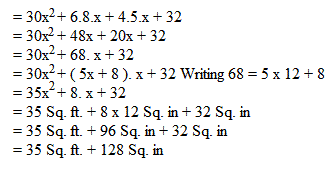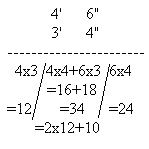This sutra means whatever the extent of its surplus, increment it still further to that very extent; and also set up the square of that surplus. This sutra is very useful in calculating the sqaures of numbers nearer(greater) to powers of 10.
For instance: in computing the square of 103 we go through the following steps:
1. The nearest power of 10 to 103 is 100.
2. Therefore, let us take 100 as our base.
3. Since 103 is 3 more than 100(base), we call 3 as the surplus.
4. Increase the given number further by an amount equal to the surplus.
i.e., perform ( 103 + 3 ) = 106. This is the left side of our answer!!.
5. On the right hand side put the square of the surplus, that is square of 3 = 09.
6. Append the results from step 4 and 5 to get the result.
Hence the answer is 10609.
Note: while calculating step 5, the number of digits in the squared number (09) should be equal to number of zeroes in the base(100). Hence in our case, the base 100 has 2 zeros and hence sqaure of 3 is 09 and not just 9.
Similarly if we need to calculate the square of 1009,
1. The nearest power of 10 to 1009 is 1000.
2. Therefore, let us take 1000 as our base.
3. Since 1009 is 9 more than 1000(base), we call 9 as the surplus.
4. Increase the given number further by an amount equal to the surplus.
i.e., perform ( 1009 + 9 ) = 1018. This is the left side of our answer!!.
5. On the right hand side put the square of the surplus, that is square of 9 = 081.(not just 81 !)
6. Append the results from step 4 and 5 to get the result.
Hence the answer is 1018081.
Try to find the square of 106 and 19 using this sutra.
Now here's a twist. What is sqaure of 112 using this rule? will this rule apply?
Answer is Yes. But we need to stick to basics and use some common sense.
Here we go...
1. & 2. the base is 100.
3. Surplus = 12
4. Increase the given number by surplus i.e. ( 112 + 12 ) = 124
5. Square of surplus, 12 = 144 . Now what?
by rule we need to consider only 2 digits in step 5 ( as the base has 2 zeros )
6. We have to append 124 and 144. The '1' in 144 becomes 'carry' to 124.
Hence the result is (124 +1 ) appended with 44 i.e., 12544 is the result.
dont get confused. try this example to make yourself more confident.
Find the square of 111. Now try to find the square of 10101.



